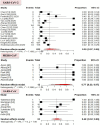The effect of coronavirus infection (SARS-CoV-2, MERS-CoV, and SARS-CoV) during pregnancy and the possibility of vertical maternal-fetal transmission: a systematic review and meta-analysis
- PMID: 32887660
- PMCID: PMC7471638
- DOI: 10.1186/s40001-020-00439-w
The effect of coronavirus infection (SARS-CoV-2, MERS-CoV, and SARS-CoV) during pregnancy and the possibility of vertical maternal-fetal transmission: a systematic review and meta-analysis
Abstract
Background: Coronavirus is challenging the global health care system from time to time. The pregnant state, with alterations in hormone levels and decreased lung volumes due to a gravid uterus and slightly immunocompromised state may predispose patients to a more rapidly deteriorating clinical course and can get a greater risk of harm for both the mother and fetus. Therefore, this systematic review was aimed to assess the effect of coronavirus infection (SARS-CoV-2, MERS-CoV, and SARS-CoV) during pregnancy and its possibility of vertical maternal-fetal transmission.
Methods: A systematic search was conducted on PubMed, Web of Science, Embase, Google Scholar and the Cochrane Library until the end of April. All authors independently extracted all necessary data using excel spreadsheet form. Only published articles with fully accessible data on pregnant women infected with SARS-CoV, MARS-CoV, and SARS-CoV-2 were included. Data on clinical manifestations, maternal and perinatal outcomes were extracted and analyzed.
Result: Out of 879 articles reviewed, 39 studies involving 1316 pregnant women were included. The most common clinical features were fever, cough, and myalgia with prevalence ranging from 30 to 97%, while lymphocytopenia and C-reactive protein were the most common abnormal laboratory findings (55-100%). Pneumonia was the most diagnosed clinical symptom of COVID-19 and non-COVID-19 infection with prevalence ranged from 71 to 89%. Bilateral pneumonia (57.9%) and ground-glass opacity (65.8%) were the most common CT imaging reported. The most common treatment options used were hydroxychloroquine (79.7%), ribavirin (65.2%), and oxygen therapy (78.8%). Regarding maternal outcome, the rate of preterm birth < 37 weeks of gestation was 14.3%, preeclampsia (5.9%), miscarriage (14.5%, preterm premature rupture of membranes (9.2%) and fetal growth restriction (2.8%). From the total coronavirus infected pregnant women, 56.9% delivered by cesarean, 31.3% admitted to ICU, while 2.7% were died. Among the perinatal outcomes, fetal distress rated (26.5%), neonatal asphyxia rated (1.4%). Only, 1.2% of neonates had apgar score < 7 at 5 min. Neonate admitted to ICU was rated 11.3%, while the rate of perinatal death was 2.2%. In the current review, none of the studies reported transmission of CoV from the mother to the fetus in utero during the study period.
Conclusion: Coronavirus infection is more likely to affect pregnant women. Respiratory infectious diseases have demonstrated an increased risk of adverse maternal obstetrical complications than the general population due to physiological changes occurred during pregnancy. None of the studies reported transmission of CoV from the mother to the fetus in utero, which may be due to a very low expression of angiotensin-converting enzyme-2 in early maternal-fetal interface cells.
Keywords: Coronavirus; Infection; Middle East respiratory syndrome; Novel coronavirus-2019; Pregnancy; Severe acute respiratory syndrome; Severe acute respiratory syndrome coronavirus-2; Vertical transmission.
Conflict of interest statement
The authors declare that they have no competing interests.
Figures
References
-
- Zaki AM, Van Boheemen S, Bestebroer TM, Osterhaus AD, Fouchier RA. Isolation of a novel coronavirus from a man with pneumonia in Saudi Arabia. N Engl J Med. 2012;367(19):1814–1820. - PubMed
-
- Organization WH. WHO director-general’s opening remarks at the media briefing on covid-19-11 march 2020. 2020; 2020.
-
- Perlman S. Another decade, another coronavirus. Mass Medical Soc; 2020.
Publication types
MeSH terms
Substances
LinkOut - more resources
Full Text Sources
Medical
Research Materials
Miscellaneous



